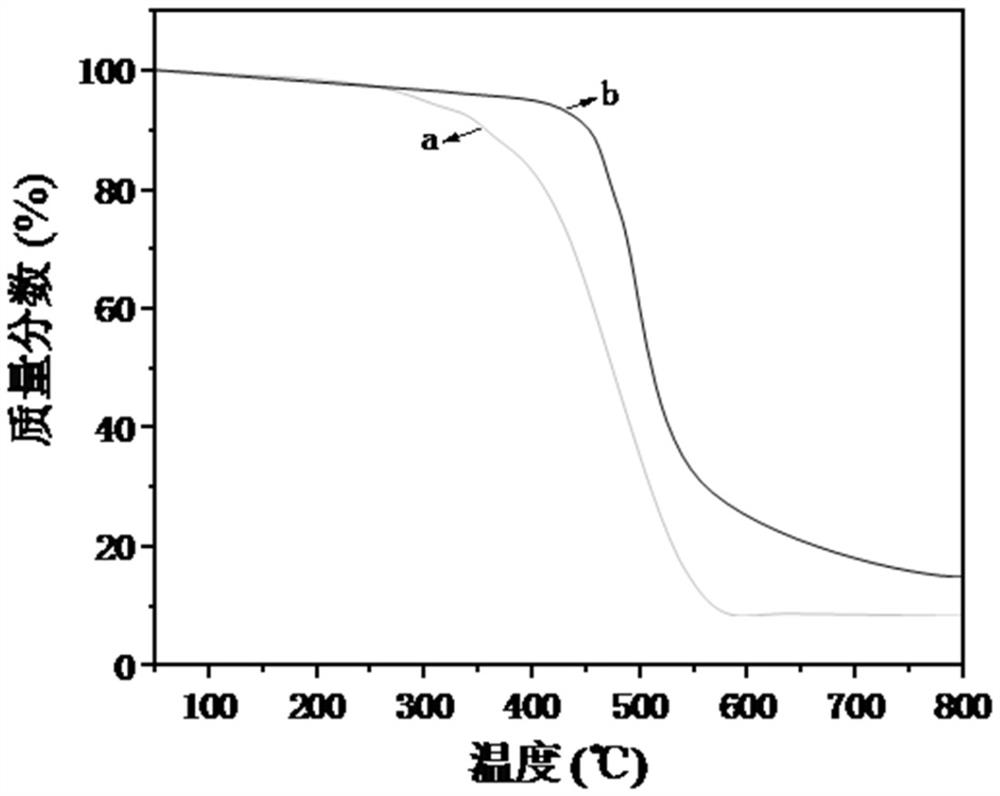Corrosion-resistant phenolic resin coating and preparation method thereof
A phenolic resin, corrosion-resistant technology, applied in the field of coatings, can solve the problems of inability to protect metal substrates, resource waste, loss, etc., and achieve the effects of good protection, improved flexibility, and strong corrosion resistance.
- Summary
- Abstract
- Description
- Claims
- Application Information
AI Technical Summary
Problems solved by technology
Method used
Image
Examples
Embodiment 1
[0026] 10.9 g (0.1 mol) of 4-hydroxybenzylamine as a reactant, 100 mL of DMF as a solvent, 1.5 eq (molar amount, relative to 4-hydroxybenzylamine) imidazole as a catalyst, and then add 1.5 eq (molar amount, relative to 4 -Hydroxybenzylamine) tert-butyldimethylsilyl chloride, react in a zero-degree ice-water bath for 4 h, remove the solvent, and purify by column chromatography to obtain A1.
[0027] 10 g A1 and 8 g polyacrylic acid (weight-average molecular weight of 450,000 g / mol, purchased from McLean) were used as reactants, 150 mL of THF was used as a solvent, and 4 g of 1-(3-dimethylaminopropyl)-3-ethyl were added Carbodiimide hydrochloride and 4 g N-hydroxysuccinimide were stirred and reacted for 4 h, filtered, and dissolved to obtain A2.
[0028] 18 g of A2 was used as the reactant, 100 mL of THF was used as the solvent, 6 g of tetrabutylammonium fluoride was added, the reaction was stirred for 4 h, and saturated NH was added. 4 Cl solution, extraction, desolvation, and...
Embodiment 2
[0033] The corrosion-resistant phenolic resin and epoxy acrylate were put into xylene, and dispersed by high-speed shearing to prepare dispersion B.
[0034] Add pentaerythritol, polyvinyl butyral, talc, glass powder, turpentine and hexamethylenetetramine into dispersion B, heat and stir to disperse, cool to room temperature and grind to obtain corrosion-resistant phenolic resin coating.
[0035] The amount of the above substances added is 100 parts of corrosion-resistant phenolic resin, 15 parts of epoxy acrylate, 10 parts of xylene, 4 parts of pentaerythritol, 5 parts of polyvinyl butyral, 3 parts of talcum powder, 3 parts of glass powder by mass ratio , 10 parts of turpentine, 18 parts of hexamethylenetetramine.
[0036] Epoxy acrylate (viscosity 42000mPa.s, purchased from Jinan Quanxing), polyvinyl butyral (weight average molecular weight 30000~45000g / mol, purchased from Shandong Xingqi Chemical, specification: 15s); glass powder purchased from Longsen, Japan; talc powder...
Embodiment 3
[0038] The corrosion-resistant phenolic resin and epoxy acrylate were put into xylene, and dispersed by high-speed shearing to prepare dispersion B.
[0039] Add pentaerythritol, polyvinyl butyral, talc, glass powder, turpentine and hexamethylenetetramine into dispersion B, heat and stir to disperse, cool to room temperature and grind to obtain corrosion-resistant phenolic resin coating.
[0040] The addition amounts of the above substances are 100 parts of corrosion-resistant phenolic resin, 20 parts of epoxy acrylate, 15 parts of xylene, 8 parts of pentaerythritol, 10 parts of polyvinyl butyral, 6 parts of talcum powder, 6 parts of glass powder by mass ratio , 15 parts of turpentine, 24 parts of hexamethylenetetramine.
PUM
| Property | Measurement | Unit |
|---|---|---|
| Weight average molecular weight | aaaaa | aaaaa |
Abstract
Description
Claims
Application Information
 Login to View More
Login to View More - R&D
- Intellectual Property
- Life Sciences
- Materials
- Tech Scout
- Unparalleled Data Quality
- Higher Quality Content
- 60% Fewer Hallucinations
Browse by: Latest US Patents, China's latest patents, Technical Efficacy Thesaurus, Application Domain, Technology Topic, Popular Technical Reports.
© 2025 PatSnap. All rights reserved.Legal|Privacy policy|Modern Slavery Act Transparency Statement|Sitemap|About US| Contact US: help@patsnap.com

